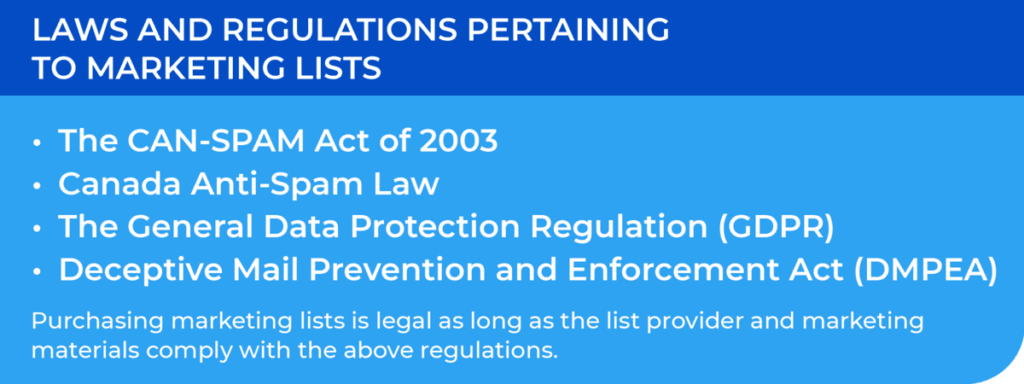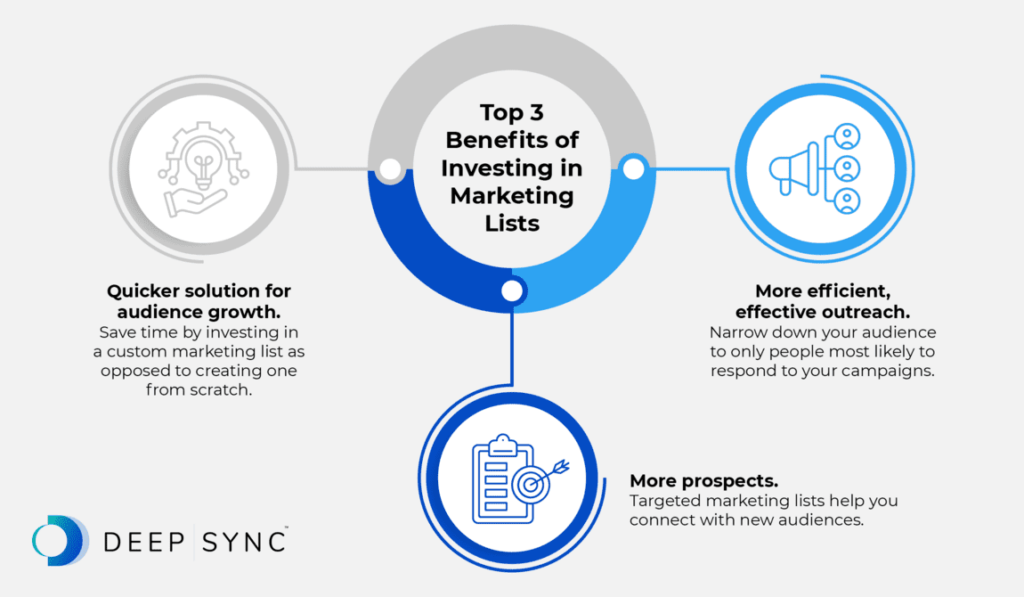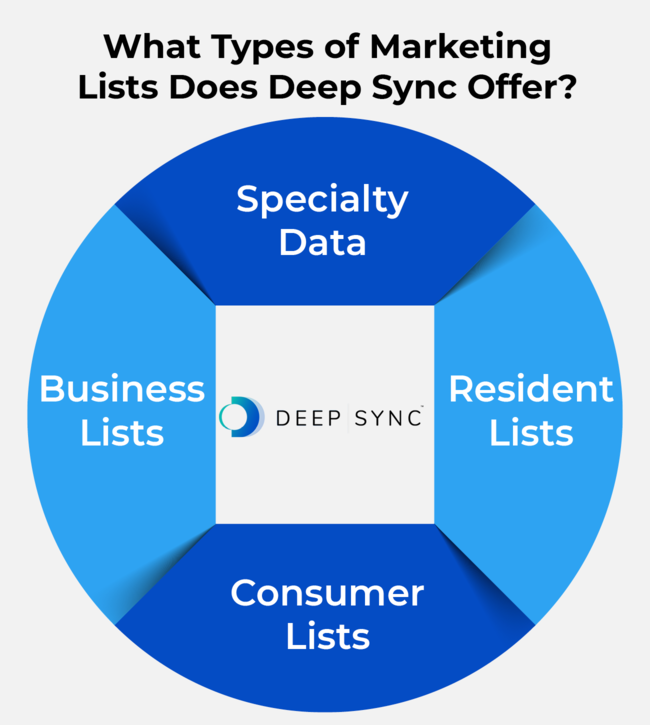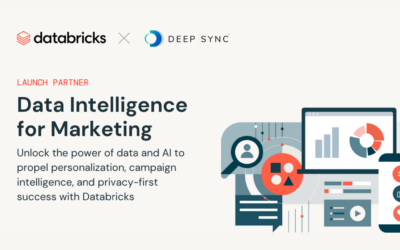Have you been trying—and struggling—to build up your marketing contacts organically? Are you preparing to launch a product into a new market in which you have few connections? Are you looking to target a particular niche audience with your latest offering?
If so, marketing lists are the key to expanding your strategy.
Marketing lists give your team access to data about your top prospects quickly and efficiently. However, there are many misconceptions about direct marketing lists—from whether they’re legal to purchase, to which types of lists to purchase, to how to go about doing so.
At Deep Sync, we specialize in helping brands, marketing agencies, and data resellers craft custom marketing lists to meet their needs. We’ve created this guide to answer all of your questions (and more!) about marketing lists through the following points:
- Frequently Asked Questions About Marketing Lists
- Deep Sync’s Marketing List Services
- How can you use marketing lists to find new customers?
Marketing lists can be an invaluable contribution to your or your clients’ outreach efforts—but only if they’re used effectively. Let’s begin with an overview of marketing lists before diving into the specifics to improve your efforts.

Frequently Asked Questions About Marketing Lists
What are marketing lists?
Marketing lists are lists of prospective customers that a business can use to increase sales and brand awareness through online and offline outreach.
These lists can be customized to help a marketer meet specific goals, such as identifying and reaching new customers within a specific geographic area or improving their direct marketing response rates. Furthermore, these lists can be used for customer acquisition efforts in email marketing, direct mailings, telemarketing, and multichannel digital marketing efforts alike.
Is it illegal to buy marketing lists?
In short, it is not illegal to purchase marketing lists. However, you should make yourself aware of any regulations surrounding the type of list you’re purchasing and the type of outreach you’re conducting. This attention to detail is valuable both when it comes to choosing a marketing list partner and when crafting your communications, ensuring both are compliant.

For example, email list regulations in the United States are dictated by the 2003 act titled “Controlling the Assault of Non-Solicited Pornography And Marketing” (CAN-SPAM). This act doesn’t make it illegal to purchase email lists, but it does set a few parameters that you need to comply with:
- Don’t use false or misleading header information or deceptive subject lines.
- Allow recipients to opt out of communications and honor those requests promptly.
- Identify the message as an advertisement.
- Include the brand’s physical postal address within the email itself.
Regulations within Canada (the Canada Anti-Spam Law) and the European Union (the ePrivacy Directive and the General Data Protection Regulation) are more restrictive when it comes to emailed communications, specifically when it comes to the need for consent before sending communications.
Just as email lists are legal to acquire, it is also legal to purchase lists containing postal addresses for use in direct mailings. However, the Deceptive Mail Prevention and Enforcement Act (DMPEA) does regulate the mailings sent, including prohibiting the implication of a federal government connection that doesn’t exist and setting stringent requirements for sweepstakes and contests.
Before purchasing a marketing list, we recommend verifying that the partner you’re purchasing from maintains regulatory compliance. For example, Deep Sync maintains 100% CAN-SPAM and Association of National Advertisers (ANA) compliance, meaning your team won’t have to worry about purchasing non-compliant data.
Why should I buy a targeted marketing list?
There are many arguments against purchasing targeted marketing lists in favor of building a list internally from scratch. These arguments posit that purchased lists provide low-quality leads and risks of regulatory non-compliance.
While that may be the case with some marketing list providers, a quality list provider such as AccuData can drastically enhance the targeting abilities of the lists you purchase and guarantee full regulatory compliance.
You can work with Deep Sync to discover what makes your ideal customer unique, create custom lists of individuals or firms that fit that persona, and rest assured that the contact information provided is carefully vetted and compliant.
When you purchase a quality marketing list from a reputable provider, you access the following benefits for your data-marketing strategy:

- More prospects, allowing expansion into new markets. Whether you’re looking to expand into a new target demographic or geographic market, purchasing a targeted marketing list can give you qualified contacts within an audience that your brand has yet to connect with.
- More efficient, effective outreach. Rather than broadcasting your outreach across an entire demographic or geographic market—such as papering every household or firm within a 25-mile radius of your target area—you can purchase a marketing list that’s targeted to only those most likely to respond to your campaigns.
- A quicker way to build your audience. Building a marketing list internally, organically, and from scratch can be a time-consuming process and ultimately slow the growth of your brand’s audience. By purchasing a marketing list, you can kick-start the process.
In the past, purchasing lists may have been a risky and low-return effort. However, the advanced targeting and customization of modern lists make purchasing them a worthwhile effort.
Are there different types of marketing lists?
There are a variety of marketing lists available for purchase, differentiated by the data needed to supplement your brand’s marketing efforts.
For example, you may purchase a more straightforward list containing the postal and email addresses of all individuals within a 25-mile radius of a store’s flagship location. Or, you might choose a multidimensional list containing information about consumers in a geographic area that also meets certain demographic or lifestyle characteristics that make them a more suitable target audience.
This additional information—such as their tastes and preferences or the presence of children in the home—could make for a more responsive audience, enabling you to strategically target people with these characteristics going forward.
This is just the tip of the iceberg when it comes to the various types of marketing lists. We’re going to look in-depth at the different types of marketing lists that you can purchase later in this guide.
How do I purchase a marketing list?
To purchase a marketing list, you’ll need to work with a data provider that specializes in list curation, such as Deep Sync. These lists can be customized to meet your campaign’s unique goals.
While there are a variety of list providers on the market, you’ll want to carefully consider the provider from which you purchase. You’ll want to seek:
- Regulatory compliance, including CAN-SPAM and ANA
- Rigorous data vetting and approval processes
- High deliverability rates
- Customization and the ability to target by precise attributes
Deep Sync offers a variety of marketing list services. We provide access to leading consumer datasets, allow marketers to access an on-demand, custom list-building platform, and provide hands-on custom solutions that draw on Deep Sync’s data science expertise to elevate your targeted marketing efforts to the next level.
Marketing Lists Available Through Deep Sync
At Deep Sync, we enable marketers to expand their reach and engage with new audiences through a variety of expansive marketing lists. After listening to your needs, we will recommend the data that will help optimize your campaign—whether it’s a direct mail, telemarketing, email, or digital campaign.
Continue reading for a closer look at the types of marketing lists we offer.

Resident Marketing Lists
Resident (or resident/occupant) data is address-based and is used for geographic saturation.
For example, let’s say a new pizza parlor has opened in your area. This pizza parlor would use resident/occupant data to target the addresses of prospects within 10 miles of their location and send direct mail advertisements to those locations. Resident/occupant data is ideal for instances when you’re targeting a broad audience in a specific geographic area, such as the opening of a new local business.
Resident/occupant data includes information such as:
- Carrier Route Saturation
- Residential Addresses
- Business Addresses
- Mapping
- Postal Presorts
This data can benefit your marketing efforts by providing a list of new locations to send direct mail. However, it can also help lower your postal costs, as it typically involves saturation mailing. The high volume of addresses can lead to postal discounts.
Consumer Marketing Lists
Consumer marketing lists are used when you need to access a more highly targeted audience. The data used to build these lists is filtered using a variety of demographic, lifestyle, and transactional characteristics to ensure the list you choose represents individuals who might be interested in what you (or your clients) are offering.
For example, let’s say a new K-12 tutoring center is opening in a neighborhood. This is the perfect time to use consumer data by narrowing down a list of prospects to homes with the “Presence of Children.” This precise targeting would prevent the tutoring center from sending advertisements to households without children.
Consumer data includes information such as:
- Age
- Marital Status
- Presence of Children
- Education
- Occupation
- Ethnicity
- Hobbies or Interests
- Household Income
- Household Composition
- Pet Ownership
- Religion
For most mailings, identifying the right prospects makes the difference between success and failure. There are many different types of marketing offers that would be best served by accessing this data—so when in doubt, try a consumer list to make your targeting more accurate.
Business Marketing Lists
If you work in a business-to-business environment, you’ll need to access business or firmographic data to improve your efforts using marketing lists. Whether you’re marketing a corporate cleaning service, targeting nonprofits for your new fundraising platform, or otherwise attracting businesses as customers, this data will help you.
Business marketing lists give you both an understanding of which companies to target and the information needed to target specific contacts within that company. This includes data such as:
- Type of Business
- Number of Employees
- Sales Volume
- Job Titles
- Contact Information
Whenever you need to target C-suite contacts or send marketing communications to a business’s physical location, you’ll want to access business lists to make sure you’re choosing the right prospects.
Specialty Data
There are times when resident/occupant, business, and consumer lists don’t cover what you need. This tends to happen when you’re targeting a specific, niche audience—such as new homeowners or doctors of a specific practice type.
In these scenarios, you’d want to access a specialty marketing list. These lists can contain data such as:
- Pre-Movers, New Movers, and New Homeowners
- Professional Contacts
- Doctors or Nurses by Practice Type
- Registered Voters by Party
- Teachers by Grade or Subject
- College Students
These lists are valuable for when you need to find a group of prospects that are focused around a certain key characteristic, such as purchasing a home, experiencing a specific ailment, or even aligning with a specific political party.
When using this type of list, make sure that you’re not going too narrow with your audience. For example, if you’re thinking of targeting college students, be sure that your offer is relevant to that specific group. If it would also be relevant for consumers within that age range who aren’t in college, you could unnecessarily restrict your list by not including them.
How can you use marketing lists to find new customers?
Let’s walk through the process of using marketing lists to find new customers and improve your outreach.
First, you would clearly define your ideal audience. You may even start with a customer profile report to identify lookalike audiences based on your best customers.
Next, you’d work with a marketing list provider—such as Deep Sync—to craft a custom list that meets your exact needs. You’ll want to make sure the company has stringent data vetting and approval processes to ensure regulatory compliance.
Finally, you’d use your list to begin contacting prospects. Whether through direct marketing or digital advertisements, your efforts will be more successful because you’ll be sending them to a higher volume of people (or organizations) that are actually within your target market.
To learn more about how you can use marketing lists to improve your data-driven marketing efforts, contact the Deep Sync team today. In the meantime, explore the following additional resources:
- Data Hygiene: How to Make Your Data Accurate and Actionable. Cleaning your data will help you determine where the gaps are in your database. Then, you can invest in marketing lists that align with your current data goals.
- Data-Driven Marketing: A Comprehensive Guide to Success. Data is the driving force for modern marketing. Explore data-driven marketing in-depth in this guide.
- Marketing List Services: Reach New Audiences. Explore Deep Sync’s marketing list solutions to enhance your data and help you identify and reach new customers.













0 Comments